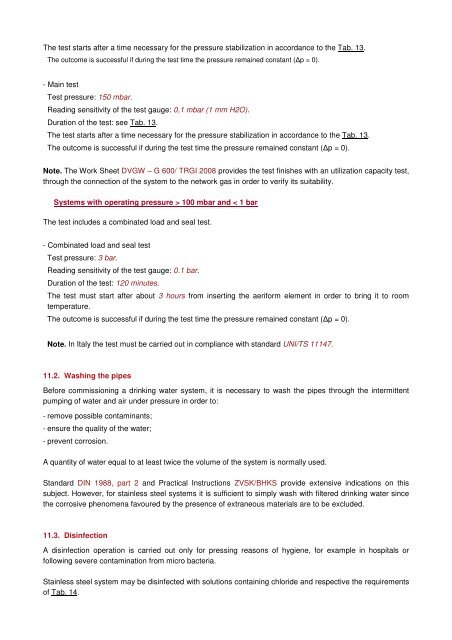Eurotubi Pressfitting System - Technical Guide ... - Damstahl
Eurotubi Pressfitting System - Technical Guide ... - Damstahl
Eurotubi Pressfitting System - Technical Guide ... - Damstahl
Create successful ePaper yourself
Turn your PDF publications into a flip-book with our unique Google optimized e-Paper software.
The test starts after a time necessary for the pressure stabilization in accordance to the Tab. 13.<br />
The outcome is successful if during the test time the pressure remained constant (∆p = 0).<br />
- Main test<br />
Test pressure: 150 mbar.<br />
Reading sensitivity of the test gauge: 0,1 mbar (1 mm H2O).<br />
Duration of the test: see Tab. 13.<br />
The test starts after a time necessary for the pressure stabilization in accordance to the Tab. 13.<br />
The outcome is successful if during the test time the pressure remained constant (∆p = 0).<br />
Note. The Work Sheet DVGW – G 600/ TRGI 2008 provides the test finishes with an utilization capacity test,<br />
through the connection of the system to the network gas in order to verify its suitability.<br />
<strong>System</strong>s with operating pressure > 100 mbar and < 1 bar<br />
The test includes a combinated load and seal test.<br />
- Combinated load and seal test<br />
Test pressure: 3 bar.<br />
Reading sensitivity of the test gauge: 0.1 bar.<br />
Duration of the test: 120 minutes.<br />
The test must start after about 3 hours from inserting the aeriform element in order to bring it to room<br />
temperature.<br />
The outcome is successful if during the test time the pressure remained constant (∆p = 0).<br />
Note. In Italy the test must be carried out in compliance with standard UNI/TS 11147.<br />
11.2. Washing the pipes<br />
Before commissioning a drinking water system, it is necessary to wash the pipes through the intermittent<br />
pumping of water and air under pressure in order to:<br />
- remove possible contaminants;<br />
- ensure the quality of the water;<br />
- prevent corrosion.<br />
A quantity of water equal to at least twice the volume of the system is normally used.<br />
Standard DIN 1988, part 2 and Practical Instructions ZVSK/BHKS provide extensive indications on this<br />
subject. However, for stainless steel systems it is sufficient to simply wash with filtered drinking water since<br />
the corrosive phenomena favoured by the presence of extraneous materials are to be excluded.<br />
11.3. Disinfection<br />
A disinfection operation is carried out only for pressing reasons of hygiene, for example in hospitals or<br />
following severe contamination from micro bacteria.<br />
Stainless steel system may be disinfected with solutions containing chloride and respective the requirements<br />
of Tab. 14.
















